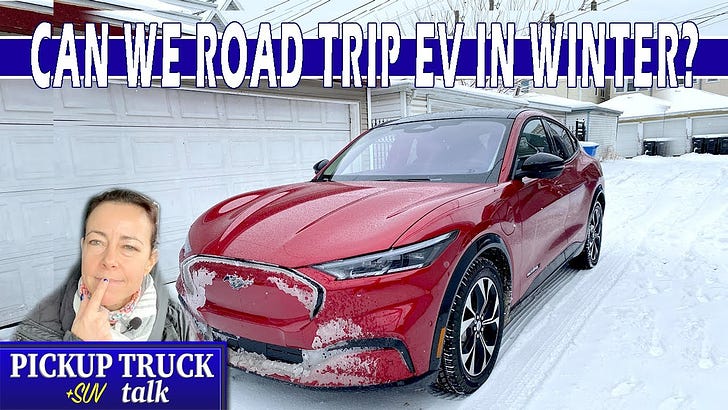Video | Winter EV Driving and Opportunity Charging
This test drive reveals what's needed for small or big road trips in the winter and how to gain some "EV freedom."
~ Plugged In - Buying and Educational Insights from EV owners.
This 17-minute Ford Mach-e Mustang video review dives into EV winter driving and reveals that electric car drivers should always be looking for destination charging to extend trips and provide EV freedom. The trip documents a test drive by Jill Ciminillo, a contributor to Pickup Truck + SUV talk, and shows how driving at 75 to 80 mph and unexpected stops in the winter can quickly drain your battery pack.
This review is great example of how a new EV driver needs to ditch their gas mindset when it comes to road trips and winter driving. First and foremost, EV drivers need to plan for EV charging opportunities when you embark on an extended metro trip or longer road trip in the winter.
In this review, Ciminillo plans to drive from Chicago to Milwaukee with a 100% charged Mustang MachE, though the electric battery bar doesn’t seem reflect 260+ miles at the start of the video. The drive from Chicago to Milwaukee can be approximately 90 to 115 miles. The trip is going fine but the reviewer takes a lunch break and then reverses course once they were near Milwaukee and come back home Chicago.
>> Related Content | Three Essential Components for a Successful Road Trip
On the way to Milwaukee, Ciminillo was driving at 65 mph and this conserved the battery range, but on the way back Ciminillo states that she wanted to keep pace with traffic and traveled at 75 to 80 mph.
Opportunity Charging
A couple of things here for new EV drivers, you really want to design your trip around opportunity charging and this is a new concept to drivers. At lunch, eating times on the road can range from 15 to 60 minutes, and a DC fast charging station will provide approximately 50 to 90 miles in 30 minutes, depending on the automaker and station.
Plugged In, a bi-monthly newsletter, taps into knowledgeable EV owners about the technology and delivers this information via guides, video reviews, explainers and podcast interviews! Subscribe to Plugged In and follow us on Twitter (@PluggedInEV).
So how do I do find charging stations and eateries? Register your EV with PlugShare and set your App’s filters for DC fast charging, Level 2 and dining. This will provide charging options and so will Ford’s partnerships with charging networks like Electrify America, see here.

The second item is highway driving at 75 to 80 mph will draw a lot of energy from the battery pack and reduce range. A great app, A Better Route Planner, allows a driver to input variables like speed, temperature and wind to provide accurate battery pack estimates while driving.
Plus, on-the-road charging opportunities add a lot of EV freedom, such as being able to drive 75 to 80 mph on the ride back home since you have “extra” range. Electric driving is different and some extra planning or awareness goes a long way in making trips stress-free.
**One note in the video, the charging times provided by the reviewer represent charging the battery pack from zero to full, which no EV owner really does. Approximately 80% of U.S. commuters, average under 40 miles of driving each day. So a level 2 charging station would take about 2 hours of charging at home each night while a level 1 (120V outlet) would take 12 to 13 hours.





Definitely one of the biggest issues is really perception. What an EV with a lower range battery can do even in brutally cold weather here in Canada is better than what people think it can do.
https://youtu.be/iNC-GqFumSU